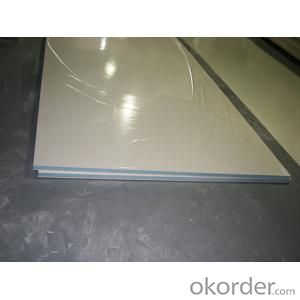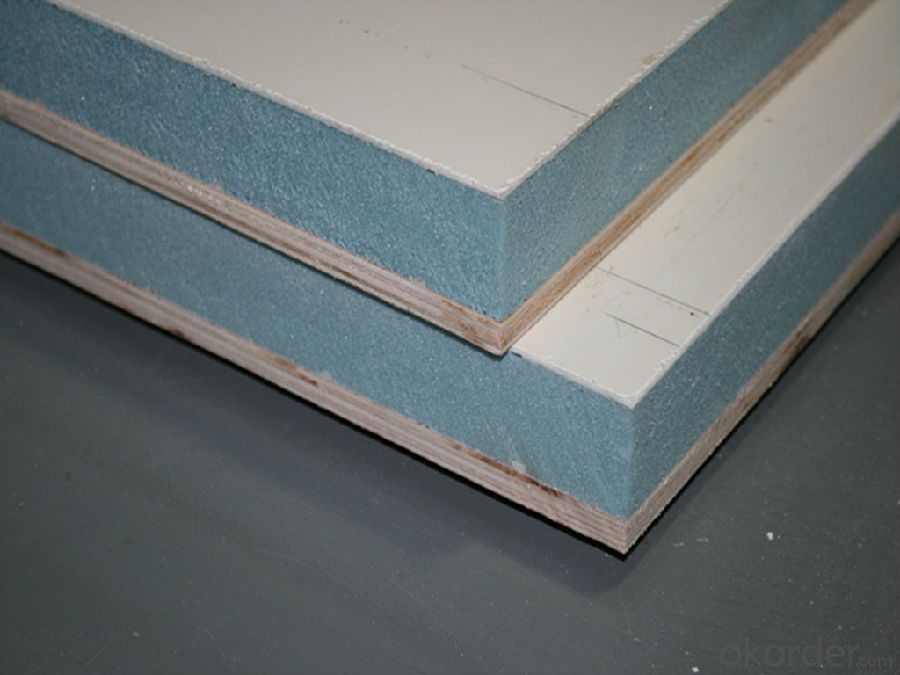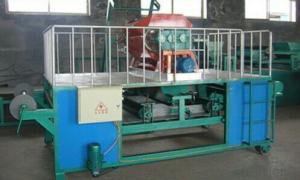FIBER REINFORCE PLASTIC PANEL/ROOFING SHEET
- Loading Port:
- Tianjin
- Payment Terms:
- TT or LC
- Min Order Qty:
- 10000 m.t.
- Supply Capability:
- 10000 m.t./month
OKorder Service Pledge
OKorder Financial Service
You Might Also Like
Specifications
FRP Sheet is made of high performance glass fibers and high quality ofunsaturated polyester resin.
Applications: sandwich panels,refrigerator car,decorative sheets, truck box body, wagon panels, dry vansheets, container panels, trailer panels, outdoor vacation panels, foodprocessing plants, cold storage, brewing beer plants, pharmaceutical factories,laboratories, hospitals, chemical plants, public bathhouses, toilets,warehouses, supermarkets, pleasure ground, schools, car washing, and yachts .Suitable for versatile indoor applications and without varnishing also foroutdoor use.
performance parameters:
1. impact resistance : Because theproduct structure contains crisscrossed glass fiber reinforced materials, greatly improve the shock resistance of the product, not easily brokendeformation...
2. corrosion resistance : It can resist kinds of acid, alkali and other chemical corrosion, especially suitablefor practical in the coastal and corrosive..
3. Easy-maintainable : FRP sheets maintenance isvery convenient, and no obvious trace after maintenance .
4. Coefficient of heat conductivity of FRPsheet is about 0.23KW/M.K,Its heat insulation performance is better than thatof steel and aluminum material..
5.Suface property: surface of FRP sheet is colorplastic suits, property is good, It can be made of food grade gelcoating,as it has this coating,the composite surface will be soomth and clean.



Product Traits
1. Corrosion resistance no rust, no maintenance, long service life.
2. Lightweight, high strength pultrusion process molding FRP profiles have high glass fiber content (60%). In this situation, the density of glass fiber reinforced plastic is only about a quarter of the steel.
3. The intensity and stiffness is quite prominent,.
4. Anti-fatigue high anti- fatigue strength, allowing repeated bending without permanent deformation.
5. Anti-aging select highquality FRP pultrusion profiles, the service life of the product can be more than 20 years.
6. Anti-UV agent are added into all pultrusion FRP profiles get the best anti-uv effect.
Product Advantage
1. Coated with prevent aging layer
2. Excellent insulating performance
3. Easy to maintain.
4. High strength.
5. Long service life.
6. Easy to install.
7. Good light transmittance.
Specification
Unit Weight: 1800g/m² 2400g/m² 3050g/m²
Nominal Thickness:0.8mm,1.0mm, 1.2mm 1.5mm 2.0mm, 2.5mm
Heat Resistance Limit: -60 to +130
Light Transmittance: 75%±2% ( light green) 53%±2% (cream white)
Anti- ultraviolet Rate: 99.9%
Tensile Strength: 100Mpa
Flexural Strength: 180Mpa
Cracking Elongation Rate: 1.9%
Pasture Hardness: ≥50
Thermal Expansion Coefficient: 2.2×10¯125px/cm/
Thermal Conductivity: 0.18w/m° k
FAQ
1.Which country do you mainly export to?
A: Our products are very popular in Mid East, India, South East Asia, Latin America, Africa.
2.Q: What’s the advantage of you compared with other suppliers experienced in foreign trade?
A: We have been specialized in FRP products for over decades years and approved by many domestic companies. Except for our quality and price, we’re also able to give you the best service.
3.Q:Can you provide some samples?
A: Yes, of course. We will send you samples for your confirmation before you place firm orders.
.
- Q:Can FRP pultrusion profiles be used in the construction of elevated walkways?
- Yes, FRP (Fiber Reinforced Polymer) pultrusion profiles can be used in the construction of elevated walkways. FRP pultrusion profiles are lightweight yet strong, making them an ideal choice for creating durable and long-lasting walkways that can withstand heavy foot traffic. They offer excellent corrosion resistance, making them suitable for outdoor applications where exposure to moisture, chemicals, and UV radiation is a concern. FRP pultrusion profiles also have high strength-to-weight ratios, allowing for easy installation and reducing the structural load on the supporting elements. Moreover, FRP profiles are non-conductive, making them a safer option for walkways in areas where electrical hazards are present. Overall, FRP pultrusion profiles offer numerous advantages that make them well-suited for the construction of elevated walkways.
- Q:How do FRP pultrusion profiles withstand extreme temperatures?
- FRP (Fiber Reinforced Polymer) pultrusion profiles are engineered to withstand extreme temperatures due to the unique properties of the materials used in their construction. Firstly, FRP pultrusion profiles are composed of a combination of reinforcing fibers, such as fiberglass or carbon fiber, and a polymer resin matrix. These fibers provide excellent strength and stiffness, while the resin acts as a protective binder, holding the fibers together and providing resistance against heat. The reinforcing fibers used in FRP pultrusion profiles have high melting points and are inherently non-combustible, allowing them to maintain their structural integrity even at elevated temperatures. This characteristic prevents the profiles from melting, warping, or becoming brittle under extreme heat conditions. Additionally, the polymer resin matrix used in FRP pultrusion profiles is carefully selected to have a high glass transition temperature (Tg). The Tg is the temperature at which the resin transitions from a rigid, glassy state to a more flexible, rubbery state. By utilizing a resin with a high Tg, FRP pultrusion profiles can withstand extreme temperatures without losing their mechanical properties. Furthermore, the manufacturing process of pultrusion itself contributes to the ability of FRP profiles to withstand extreme temperatures. During pultrusion, the reinforcing fibers are carefully impregnated with the resin matrix and then pulled through a heated die. This process ensures a uniform distribution of the resin throughout the profile, enhancing its resistance to heat and temperature fluctuations. Overall, the combination of high-performance reinforcing fibers, a carefully selected resin matrix, and the pultrusion manufacturing process enables FRP pultrusion profiles to withstand extreme temperatures, making them suitable for a wide range of applications in various industries.
- Q:Are FRP pultrusion profiles resistant to vibration or shock?
- FRP pultrusion profiles are highly resistant to vibration and shock. The inherent properties of FRP (Fiber Reinforced Polymer) materials make them ideal for applications requiring durability and strength under dynamic loading conditions. The composition of FRP profiles, which typically include a combination of reinforcing fibers and a resin matrix, provides excellent stiffness and damping characteristics. This enables FRP pultrusion profiles to effectively absorb and dissipate vibrations and shock forces, preventing damage or degradation. Additionally, the design flexibility of FRP allows for tailored reinforcement and optimization, further enhancing its resistance to vibration and shock. Therefore, FRP pultrusion profiles are a reliable choice for applications where these properties are crucial, such as in aerospace, automotive, marine, and structural engineering industries.
- Q:Can FRP pultrusion profiles be used in the renewable energy and solar power industry?
- The renewable energy and solar power industry can effectively utilize FRP (Fiber Reinforced Polymer) pultrusion profiles. These profiles possess several key characteristics that make them ideal for such applications. To begin with, the high strength-to-weight ratio of FRP pultrusion profiles is crucial in the renewable energy sector. They are lightweight yet strong, allowing them to withstand various environmental conditions while remaining cost-effective. Additionally, these profiles offer excellent corrosion resistance, ensuring durability and longevity in outdoor and potentially corrosive environments like solar power plants or wind farms. Moreover, FRP pultrusion profiles have outstanding electrical insulation properties, making them suitable for electrical applications commonly found in the renewable energy industry. Furthermore, these profiles can be easily customized into various shapes and sizes, enabling the design and engineering of complex structures required for solar power installations or wind turbine blades. Furthermore, FRP materials are non-conductive and non-magnetic, ensuring their safety for use in electrical and magnetic fields associated with renewable energy systems. In conclusion, FRP pultrusion profiles provide a combination of strength, durability, lightweight, corrosion resistance, and electrical insulation properties that make them highly suitable for use in the renewable energy and solar power industry.
- Q:Are FRP pultrusion profiles resistant to UV degradation?
- Yes, FRP pultrusion profiles are generally resistant to UV degradation. Pultrusion profiles made from fiberglass reinforced plastic (FRP) are manufactured using a combination of resin and glass fibers. The resin used in the manufacturing process is typically formulated to provide resistance to UV radiation. This UV resistance helps to protect the FRP pultrusion profiles from the harmful effects of prolonged exposure to sunlight. FRP pultrusion profiles have been extensively tested and have demonstrated excellent resistance to UV degradation. They are commonly used in outdoor applications where they are exposed to sunlight, such as in construction, infrastructure, and marine industries. UV resistance ensures that the FRP pultrusion profiles maintain their structural integrity, color, and aesthetic appearance over an extended period of time. However, it is important to note that the level of UV resistance may vary depending on the specific formulation of the resin used in the manufacturing process. Different manufacturers may use different resins with varying levels of UV stabilizers. It is recommended to consult with the manufacturer or supplier to ensure that the specific FRP pultrusion profiles being used are designed to withstand the UV conditions of the intended application. Regular maintenance and periodic inspection of the FRP pultrusion profiles are also important to ensure their long-term UV resistance. This may include cleaning, applying protective coatings, or using UV-blocking additives if necessary. By taking these precautions, the UV resistance of FRP pultrusion profiles can be further enhanced, ensuring their durability and longevity in outdoor environments.
- Q:Can FRP pultrusion profiles be used in the construction of playground equipment?
- FRP pultrusion profiles are indeed applicable in the construction of playground equipment. Renowned for their exceptional strength-to-weight ratio, resistance to corrosion, and long-lasting quality, these profiles prove to be ideal for outdoor applications like playground equipment. The versatility of these profiles allows for the creation of various structures such as slides, climbing frames, and play structures. Moreover, the ability to mold FRP pultrusion profiles into different shapes and sizes provides flexibility in design and customization options for playground equipment. An added advantage is that FRP materials are non-conductive, ensuring the safety of children. All in all, the numerous benefits offered by FRP pultrusion profiles make them an appropriate choice for constructing playground equipment.
- Q:Are FRP pultrusion profiles resistant to saltwater corrosion?
- Indeed, FRP pultrusion profiles exhibit exceptional resistance to saltwater corrosion. Their corrosion resistance is a significant advantage over traditional materials like steel or aluminum. The combination of reinforcing fibers and resin matrix in FRP profiles endows them with inherent resistance to the corrosive effects of saltwater. FRP profiles consist of a blend of glass or carbon fibers that are embedded in a thermosetting resin. These constituents do not chemically react with saltwater, effectively preventing the corrosion commonly observed in metals exposed to saltwater for prolonged periods. Additionally, the resin matrix utilized in FRP profiles acts as a protective barrier, further impeding saltwater from reaching the reinforcing fibers. The corrosion resistance of FRP pultrusion profiles renders them exceptionally suitable for applications in marine settings. Seawalls, dock fenders, offshore platforms, and marine vessels frequently employ FRP profiles due to their durability in saltwater environments. This durability guarantees long-term performance and minimizes the necessity for frequent maintenance or replacement. However, it is crucial to acknowledge that although FRP pultrusion profiles demonstrate high resistance to saltwater corrosion, they can still be influenced by other factors like UV radiation or chemical exposure. Consequently, it is vital to consider the precise environmental conditions and consult manufacturers or experts to select the most appropriate FRP profile for a given application.
- Q:Can FRP pultrusion profiles be used in telecommunications applications?
- Yes, FRP (Fiber Reinforced Polymer) pultrusion profiles can be used in telecommunications applications. FRP pultrusion profiles offer several advantages that make them suitable for telecommunications infrastructure. Firstly, FRP pultrusion profiles are lightweight yet strong, which makes them ideal for applications such as antenna supports, cable trays, and equipment racks. Their high strength-to-weight ratio allows for easier installation and transportation, while still providing the necessary structural support. Secondly, FRP pultrusion profiles are corrosion resistant, which is a crucial characteristic in telecommunication applications. Telecommunications infrastructure is often exposed to harsh environments, including moisture, chemicals, and extreme temperatures. Unlike traditional materials like steel or wood, FRP does not corrode or degrade in these conditions, ensuring long-term durability and reliability. Additionally, FRP pultrusion profiles offer electrical insulation properties, which is vital in telecommunications applications. They do not conduct electricity, making them safe for use in areas where electrical equipment is installed. This feature helps prevent electrical interference and ensures the integrity of the telecommunication system. Furthermore, FRP pultrusion profiles can be customized to meet specific design requirements. They can be manufactured in various shapes and sizes, allowing for flexibility in designing telecommunication infrastructure. This versatility makes FRP pultrusion profiles suitable for a wide range of applications within the telecommunications industry. In conclusion, FRP pultrusion profiles are well-suited for telecommunications applications due to their lightweight yet strong nature, corrosion resistance, electrical insulation properties, and customization possibilities. These attributes make them a reliable choice for supporting and protecting telecommunication infrastructure.
- Q:How do FRP pultrusion profiles perform in extreme cold temperatures?
- Due to the properties of the materials used, FRP pultrusion profiles perform exceptionally well in extremely cold temperatures. These profiles, made of FRP composites, are known for their excellent thermal insulation properties, which help maintain their structural integrity even in low temperatures. One major advantage of FRP pultrusion profiles in cold environments is their ability to resist freezing and thawing cycles. Unlike other materials, FRP does not absorb water, thus preventing expansion or contraction with temperature changes. This eliminates the risk of cracking or damage that can occur when moisture freezes and expands within traditional materials like metal or concrete. Moreover, FRP pultrusion profiles have a low coefficient of thermal expansion, meaning they do not significantly expand or contract with temperature fluctuations. This stability allows them to maintain their shape and structural integrity in extreme cold, reducing the chances of deformation or failure. Aside from their thermal properties, FRP pultrusion profiles also exhibit high strength and durability, making them suitable for various applications in construction, infrastructure, and transportation, even in harsh cold environments. They are resistant to corrosion, chemicals, and UV radiation, further enhancing their performance and longevity in extreme conditions. In conclusion, FRP pultrusion profiles are an excellent choice for applications requiring reliable performance in extreme cold temperatures. With their thermal insulation properties, resistance to freezing and thawing cycles, low coefficient of thermal expansion, and overall strength and durability, they are well-suited for various industries and environments, ensuring their continued performance even in the harshest cold conditions.
- Q:Are FRP pultrusion profiles resistant to oils and greases?
- Yes, FRP pultrusion profiles are generally resistant to oils and greases. This is because they are made from a combination of fiberglass and resin materials, which have inherent resistance to many chemicals including oils and greases. The resin used in the pultrusion process is typically a thermosetting resin, such as polyester or vinyl ester, which provides excellent resistance to chemical attack. Additionally, the fiberglass reinforcement adds strength and durability to the profiles, making them suitable for applications where exposure to oils and greases is expected. However, it is important to note that the specific resistance to oils and greases may vary depending on the type of resin and the specific chemical composition of the oils or greases. Therefore, it is recommended to consult the manufacturer or supplier for detailed information on the compatibility of FRP pultrusion profiles with specific oils and greases.
1. Manufacturer Overview |
|
|---|---|
| Location | |
| Year Established | |
| Annual Output Value | |
| Main Markets | |
| Company Certifications | |
2. Manufacturer Certificates |
|
|---|---|
| a) Certification Name | |
| Range | |
| Reference | |
| Validity Period | |
3. Manufacturer Capability |
|
|---|---|
| a)Trade Capacity | |
| Nearest Port | |
| Export Percentage | |
| No.of Employees in Trade Department | |
| Language Spoken: | |
| b)Factory Information | |
| Factory Size: | |
| No. of Production Lines | |
| Contract Manufacturing | |
| Product Price Range | |
Send your message to us
FIBER REINFORCE PLASTIC PANEL/ROOFING SHEET
- Loading Port:
- Tianjin
- Payment Terms:
- TT or LC
- Min Order Qty:
- 10000 m.t.
- Supply Capability:
- 10000 m.t./month
OKorder Service Pledge
OKorder Financial Service
Similar products
New products
Hot products
Hot Searches
Related keywords





























